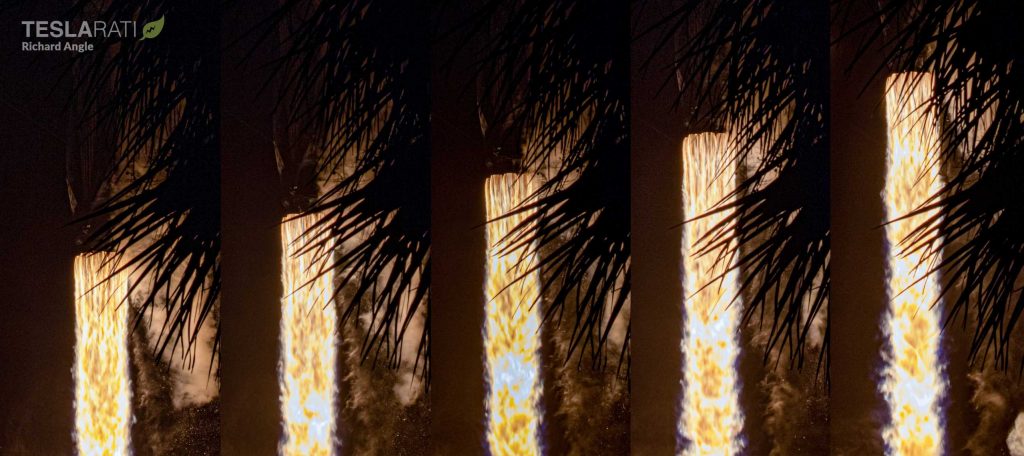Scheduled as early as next week, SpaceX’s next rocket launch could see the company break a 20-month-old record that is closely intertwined with the reusability of its Falcon 9 and Falcon Heavy boosters.
Unsurprisingly, that record – if broken – will tag along on one of up to two dozen Starlink satellite launches SpaceX has planned for 2020. The fourth launch of upgraded Starlink v1.0 satellites and fifth dedicated launch overall, SpaceX’s next Starlink mission – deemed Starlink V1 L4 – is currently set to lift off no earlier than (NET) 10:46 am EST (15:46 UTC) on February 15th. As usual, the mission’s Falcon 9 booster will attempt to land aboard drone ship Of Course I Still Love You (OCISLY), while SpaceX recovery ships Ms. Tree and Ms. Chief may attempt to catch both Falcon payload fairing halves for the third time ever.
According to Next Spaceflight, SpaceX has assigned thrice-flown Falcon 9 booster B1056 to the Starlink launch, potentially making it the fourth SpaceX rocket to complete four separate launches. However, while SpaceX’s fourth fourth-flight milestone is significant, B1056 is – barring delays – also set to break a record that could be even more important for rocket reusability.

SpaceX’s 10th finished Falcon 9 Block 5 booster, B1056 completed a flawless launch and landing debut on May 4th, 2019, sending Cargo Dragon on its way to orbit for CRS-17, the spacecraft’s 17th International Space Station (ISS) resupply mission. Instead of a more normal return-to-launch-site (RTLS) recovery at SpaceX’s Cape Canaveral-based Landing Zone, SpaceX opted to land the booster on drone ship OCISLY.

It’s believed that SpaceX and NASA made that decision out of an abundance of caution after an attempted LZ recovery following the Falcon 9 B1050’s CRS-16 Cargo Dragon launch saw the booster lose control and crash-land in the Atlantic Ocean less than a mile off the coast.
Regardless, SpaceX’s subsequent CRS-17 Cargo Dragon launch went exactly as planned and Falcon 9 B1056 landed smoothly aboard drone ship OCISLY. Less than two days after returning to Port Canaveral, B1056 even became the first SpaceX booster to have its landing legs retracted – a small but significant step along the path to true airplane-like reusability. 82 days later, B1056 successfully completed its second launch, sending another Cargo Dragon its CRS-18 resupply mission before landing at LZ-1. The booster completed its third mission a bit less than five months later, placing the 6800 kg (15,000 lb) Kacific-1 communications satellite into geostationary transfer orbit (GTO) on December 16th, 2019.


Now, SpaceX wants to launch B1056 for the fourth time as early as February 15th. Close observers will note that that would imply just 61 days between B1056’s Kacific-1 and Starlink V1 L4 launches, a feat that would make it SpaceX’s fastest ‘booster turnaround’ ever. Currently, that record stands at 71 days and was actually achieved just a month after SpaceX debuted Falcon 9’s reusability-focused Block 5 upgrade. However, that record turnaround was actually achieved by the B1045, SpaceX’s last Falcon 9 Block 4 booster.
Surprisingly, the closest SpaceX’s upgraded Block 5 rockets have gotten to beating B1045’s 71-day record was when the company turned around Falcon Heavy side boosters B1052 and B1053 in just 74 days before completing the giant rocket’s third orbital launch since February 2018. Now, barring calamities worthy of a ten-day delay, it looks likely that Falcon 9 booster B1056 will beat out the current record-holder by up to ten days (~15%).
According to a SpaceX engineer’s January 2020 presentation, SpaceX is currently capable of landing, refurbishing, and relaunching Falcon 9 and Falcon Heavy boosters in about a month (~30 days). With Falcon 9 B1056’s Starlink V1 L4 launch, SpaceX will hopefully be taking its biggest step in 20 months towards the goal of reusing Falcon boosters in a matter of days.
Check out Teslarati’s newsletters for prompt updates, on-the-ground perspectives, and unique glimpses of SpaceX’s rocket launch and recovery processes.

(adsbygoogle = window.adsbygoogle || []).push({});
<!–
–>
var disqus_shortname = «teslarati»;
var disqus_title = «SpaceX's next rocket launch on track to break a 20-month-old booster reusability record»;
var disqus_url = «https://www.teslarati.com/spacex-next-rocket-launch-new-booster-reuse-record/»;
var disqus_identifier = «teslarati-129077»;

